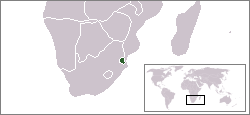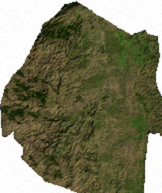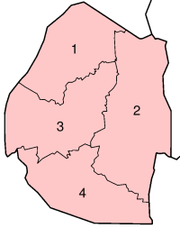Swaziland
2007 Schools Wikipedia Selection. Related subjects: African Countries; Countries
| Umbuso weSwatini Kingdom of Swaziland |
|||||
|
|||||
| Motto: "Siyinqaba" ( Swati) "We are the fortress" |
|||||
| Anthem: Nkulunkulu Mnikati wetibusiso temaSwati | |||||
| Capital | Administrative: Mbabane Royal and legislative: Lobamba |
||||
|---|---|---|---|---|---|
| Largest city | Mbabane | ||||
| Official languages | English, SiSwati | ||||
| Government | Monarchy | ||||
| - King | Mswati III | ||||
| - Indovuzaki | Queen Ntombi | ||||
| - Prime Minister | Themba Dlamini | ||||
| Independence | |||||
| - from the United Kingdom | September 6, 1968 | ||||
| Area | |||||
| - Total | 17,364 km² ( 157th) 6,704 sq mi |
||||
| - Water (%) | 0.9 | ||||
| Population | |||||
| - July 2005 estimate | 1,032,0001 ( 154th) | ||||
| - 2001 census | 1,173,900 | ||||
| - Density | 59/km² ( 135th) 153/sq mi |
||||
| GDP ( PPP) | 2005 estimate | ||||
| - Total | $5.72 billion ( 146th) | ||||
| - Per capita | $5,245 ( 101st) | ||||
| HDI (2003) | 0.498 (low) ( 147th) | ||||
| Currency | Lilangeni ( SZL) |
||||
| Time zone | ( UTC+2) | ||||
| Internet TLD | .sz | ||||
| Calling code | +268 | ||||
| 1 Estimates for this country explicitly take into account the effects of excess mortality due to AIDS; this can result in lower life expectancy, higher infant mortality and death rates, lower population and growth rates, and changes in the distribution of population by age and sex than would otherwise be expected. | |||||
The Kingdom of Swaziland is a small, landlocked country in Southern Africa (one of the smallest on the continent), situated on the eastern slope of the Drakensberg mountains, embedded between South Africa in the west and Mozambique in the east. The country is named after the Swazi, a Bantu tribe. Due in part to a high rate of HIV infection, Swaziland has the world's lowest life expectancy: 32.62 years.
History
Human remains and artifacts from more than 100,000 years ago have been found in Swaziland. The earliest inhabitants of the area were Khoisan hunter-gatherers. They were largely replaced by Bantu tribes during Bantu migrations. Evidence of agriculture and iron use dates from about the 4th century, and people speaking languages ancestral to current Sotho and Nguni languages began settling no later than the 11th century. The ruling Dlamini lineage had chiefships in the region in the 18th century. An enlarged Swazi kingdom was established by King Sobhuza I in the early 19th century. Soon thereafter the first whites started to settle in the area. In the 1890s the South African Republic in the Transvaal claimed sovereignty over Swaziland but never fully established power. After the South African War of 1899– 1902, Swaziland became a British protectorate. The country was eventually granted independence on September 6, 1968. Since then, Swaziland has seen a struggle between pro-democracy activists and the totalitarian monarchy.
Politics
The head of state is the king, currently King Mswati III, who ascended to the throne upon the death of his father King Sobhuza II in 1986. By tradition, the king reigns along with his mother (the Indlovukazi, lit. Great She-Elephant), the former viewed as the administrative head of state and the latter as a spiritual and national head of state. As the monarch, the king not only appoints the prime minister — the head of government — but also appoints a small number of representatives for both chambers of the Libandla (parliament). The Senate consists of 30 members, while the House of Assembly has 65 seats, 55 of which are occupied by elected representatives (elections are held every 5 years in November). It is important to note that with so much power is in the hands of the king, effectively Swaziland is an absolute monarchy, despite the presence of a nominally democratic parliamentary system.
The constitution that was adopted in 1968 was suspended in 1973 in a State of Emergency decree presumably still in force today, though the government claims that it has been dissolved. In 2001 King Mswati III appointed a committee to draft a new constitution. Drafts were released for comment in May 2003 and November 2004. However, they were strongly criticized by civil society organizations in Swaziland and human rights organizations elsewhere. In 2005, the constitution was put into effect, though there is still much debate in the country about that issue.
King Mswati III is often strongly criticized for living so lavishly in a nation that is afflicted by the world's highest HIV infection rates at 42.6 percent. His fleet of luxury cars, and the millions spent towards refurbishing his numerous wives' luxury mansions, are at odds with the approximately 34 percent of the population that stand unemployed, and nearly 70 percent of the population who live on less than a dollar a day. Swaziland is one of the poorest nations in the world, although one of the wealthier nations in Africa, and has a very low HDI development score.
Geography
Swaziland offers a wide variety of landscapes, from the mountains along the Mozambican border to savannas in the east and rainforest in the northwest. Several rivers flow through the country, such as the Lusutfu River. With 50,000 inhabitants, the capital, Mbabane, is the largest town in the country; other large towns include Manzini, Lobamba and Siteki.
Administrative divisions
Swaziland is divided into four districts:
- Hhohho
- Lubombo
- Manzini
- Shiselweni
Economy
Swaziland ranks among the more prosperous countries in Africa. Most of the high-level economic activity is in the hands of non-Africans, but ethnic Swazis are becoming more active. Small entrepreneurs are moving into middle management positions. 70% of Swazis live in rural areas and are being ravaged by drought and a resulting food crisis that threatens hundreds of thousands with hunger. The past few years have seen wavering economic growth, which has been exacerbated by the economy's inability to create new jobs at the same rate that new job seekers enter the market. This is due largely in part to the country's population growth rate that strains the natural heritage and the country's ability to provide adequate social services, such as health care and education. Overgrazing, soil depletion, drought, and floods are persistent problems. In 2004 Swaziland acknowledged for the first time that it suffered an AIDS crisis, with 42.6% of the population infected with HIV (see AIDS_in_Africa). Prime Minister Themba Dlamini declared a humanitarian crisis due to the combined effect of drought and land degradation, increased poverty, and HIV/AIDS. The United Nations special envoy on AIDS, Stephen Lewis, said: “Swaziland stands alone with the world's highest rate of HIV infection after nearby Botswana made headway against the deadly pandemic”
Nearly 60% of Swazi territory is held by the Crown in the trust of the Swazi nation. The balance is privately owned, much of it by foreigners. The questions of land use and ownership remains a very sensitive one. For Swazis living on rural homesteads, the principal occupation is either subsistence farming or livestock herding. Culturally, cattle are important symbols of wealth and status, but they are being used increasingly for milk, meat and profit.
Swaziland enjoys well-developed road links with South Africa. It also has railroads running east to west and north to south. The older east-west link, called the Goba line, makes it possible to export bulk goods from Swaziland through the Port of Maputo in Mozambique. Until recently, most of Swaziland's imports were shipped through this port. Conflict in Mozambique in the 1980s diverted many Swazi exports to ports in South Africa. A north-south rail link, completed in 1986, provides a connection between the Eastern Transvaal (now Mpumalanga) rail network and the South African ports of Richards Bay and Durban.
The sugar industry, based solely on irrigated cane, is Swaziland's leading export earner and private-sector employer. Soft drink concentrate (a U.S. investment) is the country's largest export earner, followed by wood pulp and lumber from cultivated pine forests. Pineapple, citrus fruit, and cotton are other important agricultural exports.
Swaziland mines coal and diamonds for export. There also is a quarry industry for domestic consumption. Mining contributes about 1.8% of Swaziland's GDP each year but has been declining in importance in recent years.
Recently, a number of industrial firms have located at the industrial estate at Matsapha near Manzini. In addition to processed agricultural and forestry products, the fast-growing industrial sector at Matsapha also produces garments, textiles, and a variety of light manufactured products. The Swaziland Industrial Development Company (SIDC) and the Swaziland Investment Promotion Authority (SIPA) have assisted in bringing many of these industries to the country. Government programs encourage Swazi entrepreneurs to run small and medium-sized firms. Tourism also is important, attracting more than 424,000 visitors annually (mostly from Europe and South Africa).
From the mid-1980s foreign investment in the manufacturing sector boosted economic growth rates significantly. Since mid-1985, the depreciated value of the currency has increased the competitiveness of Swazi exports and moderated the growth of imports, generating trade surpluses. During the 1990s, the country often ran small trade deficits. South Africa and the European Union are major customers for Swazi exports. The United States is a significant market for Swazi sugar, a market that would presumably extend to textiles should Swaziland become a beneficiary of the African Growth Opportunity Act.
Swaziland, Lesotho, Botswana, Namibia, and the Republic of South Africa form the Southern African Customs Union (SACU), where import duties apply uniformly to member countries. Swaziland, Lesotho, Namibia, and South Africa also are members of the Common Monetary Area (CMA) in which repatriation and unrestricted funds are permitted. Swaziland issues its own currency, the lilangeni (plural: emalangeni), which is at par with the South African rand.
Swaziland is in the process or formulating an Action Programme on the Elimination of Child Labour, which is expected to be adopted in the period 2006-2007.





